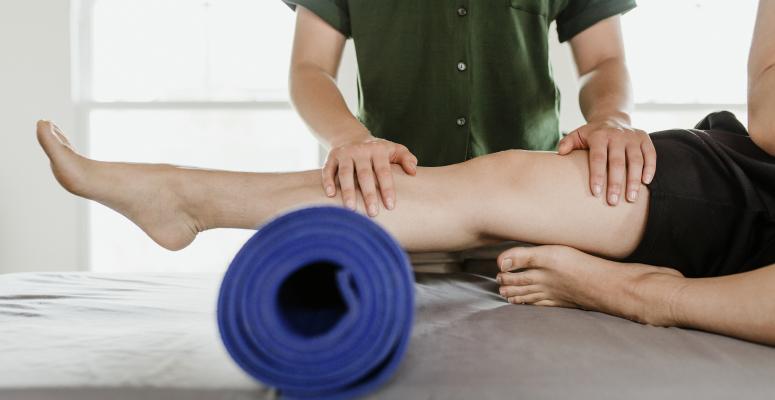
Physical therapy is a crucial aspect of recovering from an injury or managing a chronic condition. A major part of physical therapy treatment involves at-home exercises. In fact, physical therapists routinely prescribe at-home exercises to boost their patients’ recovery outside of the clinic. But is it possible to do only physical therapy at home and still reap the benefits?
Whether you're looking to save time, avoid traveling, or simply prefer the convenience of home-based care, knowing the pros and cons of doing physical therapy at home can help you make an informed decision about what's best for your health.
What are the benefits of doing PT at home?
If you’ve been feeling the aches and pains of a recent injury, you may be looking for a convenient at-home exercise to ease your symptoms. Doing physical therapy at home can be a great option for some people, but it may not be suitable for everyone. It is important to consider your individual circumstances, the severity of your condition, and your overall health before deciding whether to do PT at home or in a clinical setting.
The advantages of doing physical therapy at home include the following:
- Convenience — At-home physical therapy allows for a flexible schedule and eliminates the need for transportation.
- Cost-effectiveness — At-home physical therapy can help you save money on clinic visits and copays.
- Independence — Doing physical therapy at home can help you build confidence and independence as you perform daily exercises and build strength at your own pace and on your own schedule.
While doing physical therapy at home can have many advantages, it can also come with setbacks and risks. Disadvantages of doing PT at home can include:
- Lack of equipment — Without access to professional physical therapy equipment, your at-home PT may be limited and may not help your injury heal properly. In addition, without an in-person physical therapist to guide you in the use of equipment, you can be at a higher risk of worsening your existing injury.
- Lack of professional guidance — If you’re doing physical therapy at home, it can be important to do it with the guidance of a live physical therapist. Without the supervision of a therapist, you may have a higher risk of performing exercises incorrectly and overstretching your muscles, tendons, and ligaments.
- Difficulty in measuring progress — Without the professional measurement tools and techniques used in a clinical setting, your progress may be harder to track. Without pinpointing your progress, it can be difficult to know how you need to adjust your exercises accordingly.
- Limited modalities — In a clinical setting, physical therapists can supplement your physical therapy exercises with modalities like aquatic therapy and the Graston Technique®. At home, however, your access to modalities and their techniques is limited.
It’s important to note that not all conditions can be treated through at-home exercises and stretches. Depending on your condition, you may still need in-person evaluations and treatments.
How can you do PT at home?
If you decide to do physical therapy at home, you can try the following exercises:
- Body weight exercises — If one of your concerns is muscle weakness, you can use body weight exercises that can easily build your strength over time. Pushups, squats, lunges, planks and situps can be done without equipment. You can also perform yoga and Pilates exercises to improve flexibility, balance, and core strength.
- Resistance bands — Using resistance bands can help you target certain muscle groups and build their strength. Resistance bands are versatile and portable, making them a great option for home workouts.
- Virtual physical therapy — Virtual physical therapy, also known as telehealth physical therapy or online physical therapy, is a form of physical therapy that is delivered through remote means such as videoconferencing rather than in person. During virtual physical therapy sessions, a licensed physical therapist can assess your condition, provide a diagnosis and develop a personalized treatment plan. This may include therapeutic exercises, manual therapy techniques and other interventions. Your therapist can also monitor your progress and adjust your treatment plan as needed. Virtual physical therapy can be especially beneficial if you have mobility limitations or live in a rural area with limited access to physical therapy services.
Before doing physical therapy at home, you need to remember to warm up and cool down properly. You should also consult a medical professional to start a new exercise program, especially if you have any medical conditions or injuries.
Alliance PTP is ready to help you find top-notch PT, both at home and in person
Are you considering doing physical therapy at home? You can speak to a professional physical therapist to explore your options. At Alliance Physical Therapy Partners, we’re proudly bringing together physical therapy practices across the country to help people get the high-quality PT they need.
Want to see a physical therapist in person? We can put you in touch with an Alliance PTP partner that’s close to you and that can help you address your injury or condition.
Not keen on in-person PT sessions or not close to an Alliance PTP partner? No worries. We also offer effective and affordable virtual physical therapy through our Agile Virtual Physical Therapy platform.
Come find help for your injury or chronic condition today!
Get Help at a Location Near You
